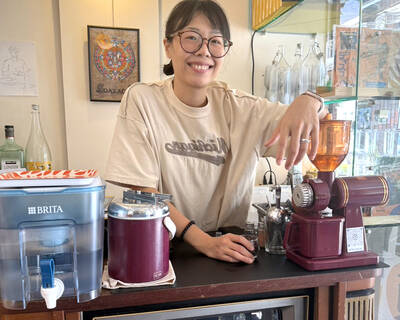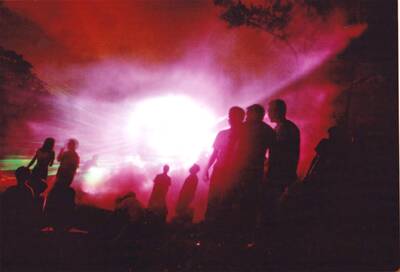Although it has been superceded as the main transport link between Changhua County and Yunlin County, the Hsiluo Bridge has retained its place in the hearts of local residents. The bridge, which was completed in 1952, will be celebrating its 50th anniversary as the center of a cultural festival designed to showcase the tourism potential of two of Taiwan's less high-profile counties.
Started in 1937, when Taiwan was still a Japanese colony, construction of the bridge was delayed by World War II and was only completed with American funding in 1952. At the time, at nearly 2km in length, it was the longest bridge in Asia and served as a major artery of north-south transportation. This role has since been overtaken by the newer expressways, but the bridge remains a powerful symbol of unity -- at least, on this occasion, when the two county governments have got together to throw the biggest party ever for this local engineering monument.
The highlight of the event will be regular displays of martial arts put on by the Yunlin county government -- in what was once a rough and wild area, Yunlin had the reputation of producing the best martial artists -- and copious displays of flowers, for which Changhua is famous. In addition, many other local specialties will be on display, with temporary rice and soy source museums set up on the Yunlin side of the bridge -- both products for which the county is famous.
According to Lin Re-yang (林日揚), head of the Yunlin Tourism Bureau, local enthusiasm for the event has been so great that there have been twice the number of applications for stall space as stalls available.
Last year, official figures for attendance at the Hsiluo Bridge Festival was 300,000 people, but Lin said that with all the additional activities put on for the 50th anniversary, he expected at least 500,000 over the nine-day event this year.
Puppeteer Huang Hai-tai (
The festival is the prelude to a comprehensive revamp of the bridge into a tourist attraction that Lin hopes will bring domestic tourist dollars to both Yunlin and Changhua counties. "We will be spending quite a lot of money putting lighting along the length of the bridge, making it a lovely environment in which people can drink coffee and relax," he said.
While the bridge is still used by pedestrian traffic -- mainly vegetable farmers taking the produce to market -- Lin said that even this function will come to an end in around two years, and there is a proposal at the moment to turn the bridge into a sculpture corridor.
The opening ceremony for the festival will take place between 5pm and 9pm tomorrow along the length of the bridge and there will be events daily through to next Sunday.

Cheng Ching-hsiang (鄭青祥) turned a small triangle of concrete jammed between two old shops into a cool little bar called 9dimension. In front of the shop, a steampunk-like structure was welded by himself to serve as a booth where he prepares cocktails. “Yancheng used to be just old people,” he says, “but now young people are coming and creating the New Yancheng.” Around the corner, Yu Hsiu-jao (饒毓琇), opened Tiny Cafe. True to its name, it is the size of a cupboard and serves cold-brewed coffee. “Small shops are so special and have personality,” she says, “people come to Yancheng to find such treasures.” She

The low voter turnout for the referendum on Aug. 23 shows that many Taiwanese are apathetic about nuclear energy, but there are long-term energy stakes involved that the public needs to grasp Taiwan faces an energy trilemma: soaring AI-driven demand, pressure to cut carbon and reliance on fragile fuel imports. But the nuclear referendum on Aug. 23 showed how little this registered with voters, many of whom neither see the long game nor grasp the stakes. Volunteer referendum worker Vivian Chen (陳薇安) put it bluntly: “I’ve seen many people asking what they’re voting for when they arrive to vote. They cast their vote without even doing any research.” Imagine Taiwanese voters invited to a poker table. The bet looked simple — yes or no — yet most never showed. More than two-thirds of those

In July of 1995, a group of local DJs began posting an event flyer around Taipei. It was cheaply photocopied and nearly all in English, with a hand-drawn map on the back and, on the front, a big red hand print alongside one prominent line of text, “Finally… THE PARTY.” The map led to a remote floodplain in Taipei County (now New Taipei City) just across the Tamsui River from Taipei. The organizers got permission from no one. They just drove up in a blue Taiwanese pickup truck, set up a generator, two speakers, two turntables and a mixer. They

Former Chinese Nationalist Party (KMT) chairwoman Hung Hsiu-chu’s (洪秀柱) attendance at the Chinese Communist Party’s (CPP) “Chinese People’s War of Resistance Against Japanese Aggression and the World Anti-Fascist War” parade in Beijing is infuriating, embarrassing and insulting to nearly everyone in Taiwan, and Taiwan’s friends and allies. She is also ripping off bandages and pouring salt into old wounds. In the process she managed to tie both the KMT and the Democratic Progressive Party (DPP) into uncomfortable knots. The KMT continues to honor their heroic fighters, who defended China against the invading Japanese Empire, which inflicted unimaginable horrors on the